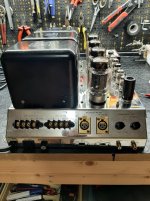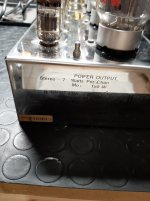Hi I'm new to this froum a greeting to all .... I have a problem with my MC 275 I think it is the SS version (serial number E10381), in particular one of the two NTCs on the primary of the power transformer T1 has blown and in phase a loud metallic hum is heard when listening. I replaced the NTC with one with the same code (CL 70). Now the mechanical hum has subsided but there is a loud noise on the speakers and when listening it feels distorted .... Can anyone tell me what to check and where to download the wiring diagram for this model? (I find schematics of other versions but not of this one). Thanks in advance...
MC275 is a tube model, can you post some photos of the amp and its model tag? Check here, the model history:
McIntosh Production History
McIntosh Production History
Last edited:
I have a service manual for the Gordon J. Gow edition from the mid-Naughties that is probably like your Stainless Steel chassis version. Miniature valves are 12AX7s and 12AZ7s?
For safety's sake, first test for the -150 VDC supplying the 12AZ7 cathode followers (4th and 7th from the left facing as in your middle picture. Each is fed from two 18K Ohm resistors in series; measure at the far end from the valves' cathodes (pins 3 and 8).
If that's OK, you can start looking for some new B+ capacitors. Or, for rigour, put a scope to the output of the rectifier bridge, then order the capacitors. I can highly recommend Hayseed Hamfest, but Mc might be willing to sell you some.
All good fortune,
Chris
For safety's sake, first test for the -150 VDC supplying the 12AZ7 cathode followers (4th and 7th from the left facing as in your middle picture. Each is fed from two 18K Ohm resistors in series; measure at the far end from the valves' cathodes (pins 3 and 8).
If that's OK, you can start looking for some new B+ capacitors. Or, for rigour, put a scope to the output of the rectifier bridge, then order the capacitors. I can highly recommend Hayseed Hamfest, but Mc might be willing to sell you some.
All good fortune,
Chris
I would start with some basic fault isolation. Do both channels have the same problem or just one channel.
Then the power supply is the most likely problem, unless all the tubes are run down.
Measure all the power supply circuit nodes, starting at the output of the HV rectifier.
Measure all the power supply circuit nodes, starting at the output of the HV rectifier.
Probably a filter capacitor type problem, likely the ones right after the rectifiers. He'd have to do some
voltage measuring and see some scope waveforms to narrow it down. Seems this amp is around 30 years old.
voltage measuring and see some scope waveforms to narrow it down. Seems this amp is around 30 years old.
Last edited:
Here is another fault isolation question: Has this amp been sitting around turned off for years collecting dust? Or it has been running off and on the past couple of years.
The fault occurred following a lack and fast return of the 220vac mains voltage. I also believe the problem is on the power supply, in fact one of the two burnt NTC (CL 70) present on the primary is a clue. So as recommended I would like to check the various voltage nodes and but I need the wiring diagram corresponding to my model. Thank you
Power supplies don't vary a whole heckuvalot. If you have a scope, look at the + terminal of the rectifier bridge. Assuming you've checked for -150 VDC first. If you don't have a scope, now's a good time to get invested.
All good fortune,
Chris
All good fortune,
Chris
Here is another fault isolation question: Has this amp been sitting around turned off for years collecting dust? Or it has been running off and on the past couple of years.
it worked great. the problem occurred while listening
Well, he introduced the power supply problem in post 1 .. Have a look.
I can't find post 1 ... thanks
If you have a short interruption in mains power, long enough that the reservoir caps can deplete but the thermistor is still hot, so it cannot limit inrush current when power comes back on. Such a scenario often takes out the rectifier bridge or one of the diodes if it is built from 4 diodes. Disconnect from mains, wait until caps are depleted ( measure voltage across caps to make shure they are at zero ) then test each of the 4 rectifier diodes for shorts with ohm meter. If a diode reads near zero ohm in both directions, it is gone ... in which case I would replace all 4. Type like 1N5408 should be good enough.
- Home
- Amplifiers
- Tubes / Valves
- McIntosk MC 275 SS


